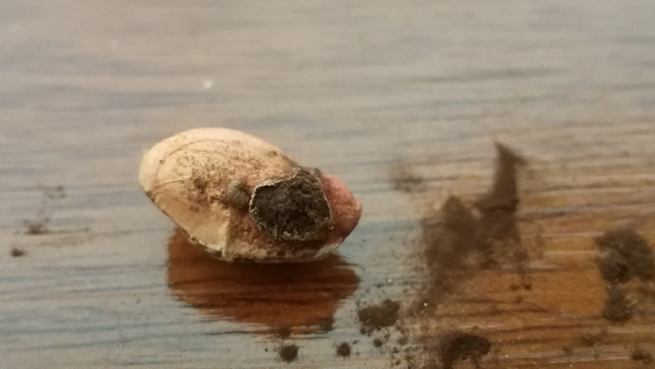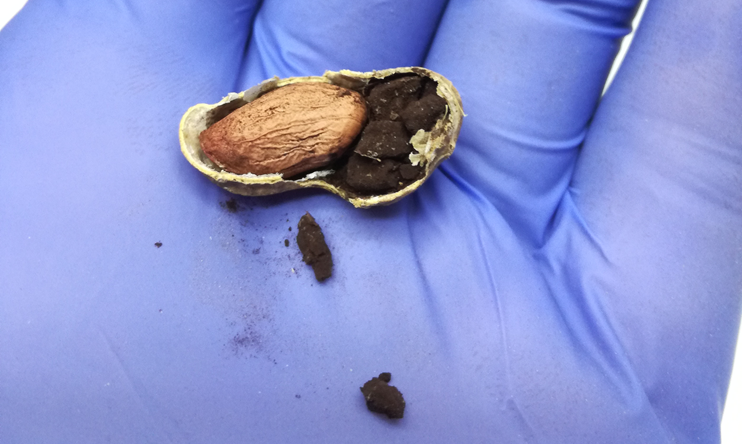Devising a Strategy Against Peanut Smut (Thecaphora frezii), the Most Damaging Threat to Peanut Farming
By Mariano Maestro
Peanut smut (Thecaphora frezii) is currently the most damaging disease of this crop in Argentina, the largest exporter of peanuts in the world. This raises concerns over the risk of the disease spreading across the world. The smut develops within the pods, and its severity can range from small brown pustules on the seeds, to their complete replacement with fungal spores (Figure 1, a and b). Because it only affects the parts of the plant that are below ground, its incidence and severity are hard to assess. Moreover, even at low levels of infection the peanuts are rendered unmarketable for confectionery grade. Resistant peanut varieties have been developed, but their effectivity over time could depend on the genetic variability of the smut. For this reason, the ARS is working closely with the Foundation for the Study of Invasive Species (FuEDEI) and the National Institute for Agricultural Technology (INTA) to discover how many strains of the disease exist within its current distribution. For this we have collected geographically distant samples of peanut smut to compare their DNA using molecular methods. Samples of peanut smut from all parts of Argentina were procured in cooperation with private stakeholders, and through field surveys of domesticated and wild species of peanuts (Figure 2).
Because T. frezii requires infecting a live plant to complete its life cycle, studying it in the lab can be a challenge. For this reason, a protocol for in vitro germination of peanut smut spores was developed at FuEDEI (Figure 3), as well as a protocol for multiplication in liquid medium which allows the production of sufficient quantities of biomass for DNA extraction. Samples of live mycelium cultivated in vitro using this method were shipped in July 2023 to the USDA-ARS Foreign Disease Weed Science Research Unit (Fort Detrick, MD), where it is currently being studied, and new samples will be sent in June.

Figure 1a: Diseased peanut seed with one sorus (medium severity)

Figure 1b: Diseased peanut pod where one of the seeds has been completely replaced by spores of T. frezii (high severity)

Figure 2: Wild species of Arachis on the field in Argentina

Figure 3: In vitro culture of peanut smut
For inquiries regarding this article contact: info@fuedei.org.
The Foundation for the Study of Invasive Species (FuEDEI), formerly known as the South American Biological Control Laboratory (SABCL), is located in Hurlingham, Argentina, near Buenos Aires. The SABCL/FuEDEI plays a crucial role collecting and providing candidate biological control agents for South American weeds and pest insects for federal and state cooperators, several U.S. universities, and research collaborators worldwide since 1962. FuEDEI’ s main mission includes exploring for natural enemies of target insects and weeds in Argentina and neighboring countries and conducting host-specificity testing to determine their safety for eventual release in the U.S. In addition, complementary research that investigates the ecology, behavior, taxonomy, and genetic differences based on geographic distribution is conducted on both targets and potential agents. Performing these studies in the region of origin of the target pest serves as an efficient prescreening process that reduces the number of biocontrol agent candidates shipped. This reduces the amount of quarantine work and valuable quarantine space occupation, the expenses related to permitting processes, the risks of escapes, and the release of maladapted or wrongly identified agents to a minimum, saving in costs and hazards. On some occasions these complementary studies help us understand why an exotic organism becomes invasive, which can, in turn, lead to determining novel strategies for their management.
